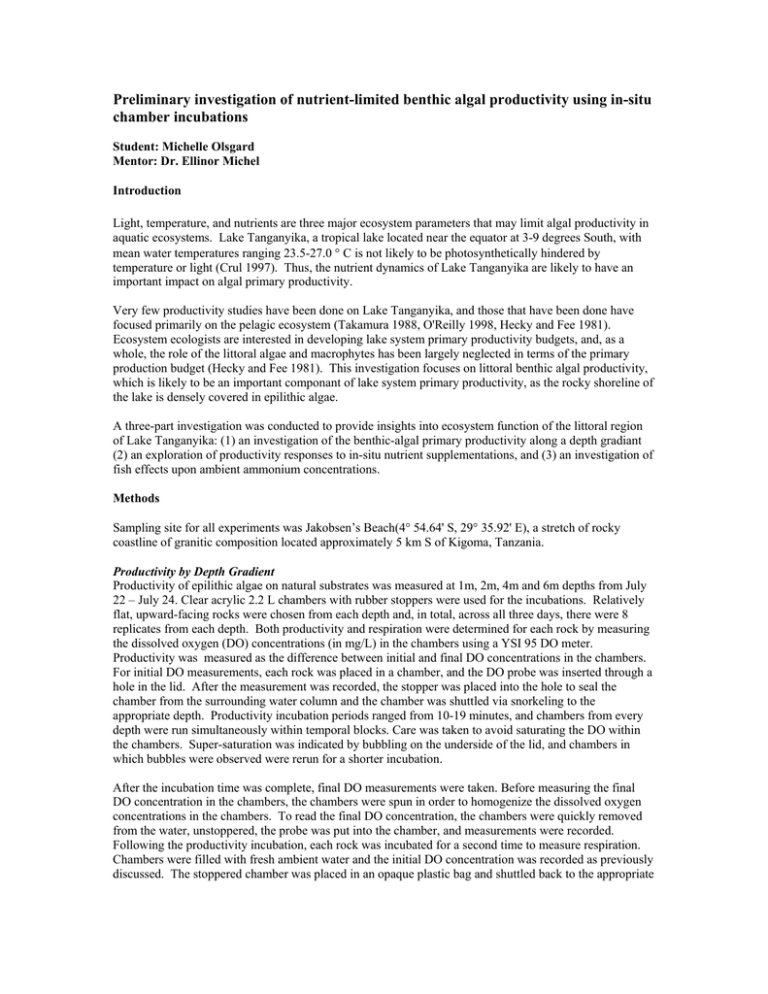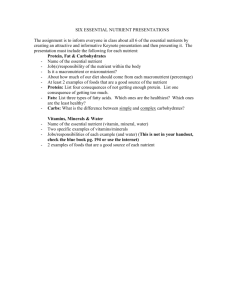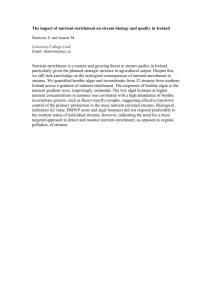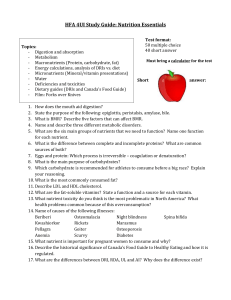Preliminary investigation of nutrient-limited benthic algal productivity using in-situ chamber incubations
advertisement

Preliminary investigation of nutrient-limited benthic algal productivity using in-situ chamber incubations Student: Michelle Olsgard Mentor: Dr. Ellinor Michel Introduction Light, temperature, and nutrients are three major ecosystem parameters that may limit algal productivity in aquatic ecosystems. Lake Tanganyika, a tropical lake located near the equator at 3-9 degrees South, with mean water temperatures ranging 23.5-27.0 ° C is not likely to be photosynthetically hindered by temperature or light (Crul 1997). Thus, the nutrient dynamics of Lake Tanganyika are likely to have an important impact on algal primary productivity. Very few productivity studies have been done on Lake Tanganyika, and those that have been done have focused primarily on the pelagic ecosystem (Takamura 1988, O'Reilly 1998, Hecky and Fee 1981). Ecosystem ecologists are interested in developing lake system primary productivity budgets, and, as a whole, the role of the littoral algae and macrophytes has been largely neglected in terms of the primary production budget (Hecky and Fee 1981). This investigation focuses on littoral benthic algal productivity, which is likely to be an important componant of lake system primary productivity, as the rocky shoreline of the lake is densely covered in epilithic algae. A three-part investigation was conducted to provide insights into ecosystem function of the littoral region of Lake Tanganyika: (1) an investigation of the benthic-algal primary productivity along a depth gradiant (2) an exploration of productivity responses to in-situ nutrient supplementations, and (3) an investigation of fish effects upon ambient ammonium concentrations. Methods Sampling site for all experiments was Jakobsen’s Beach(4° 54.64' S, 29° 35.92' E), a stretch of rocky coastline of granitic composition located approximately 5 km S of Kigoma, Tanzania. Productivity by Depth Gradient Productivity of epilithic algae on natural substrates was measured at 1m, 2m, 4m and 6m depths from July 22 – July 24. Clear acrylic 2.2 L chambers with rubber stoppers were used for the incubations. Relatively flat, upward-facing rocks were chosen from each depth and, in total, across all three days, there were 8 replicates from each depth. Both productivity and respiration were determined for each rock by measuring the dissolved oxygen (DO) concentrations (in mg/L) in the chambers using a YSI 95 DO meter. Productivity was measured as the difference between initial and final DO concentrations in the chambers. For initial DO measurements, each rock was placed in a chamber, and the DO probe was inserted through a hole in the lid. After the measurement was recorded, the stopper was placed into the hole to seal the chamber from the surrounding water column and the chamber was shuttled via snorkeling to the appropriate depth. Productivity incubation periods ranged from 10-19 minutes, and chambers from every depth were run simultaneously within temporal blocks. Care was taken to avoid saturating the DO within the chambers. Super-saturation was indicated by bubbling on the underside of the lid, and chambers in which bubbles were observed were rerun for a shorter incubation. After the incubation time was complete, final DO measurements were taken. Before measuring the final DO concentration in the chambers, the chambers were spun in order to homogenize the dissolved oxygen concentrations in the chambers. To read the final DO concentration, the chambers were quickly removed from the water, unstoppered, the probe was put into the chamber, and measurements were recorded. Following the productivity incubation, each rock was incubated for a second time to measure respiration. Chambers were filled with fresh ambient water and the initial DO concentration was recorded as previously discussed. The stoppered chamber was placed in an opaque plastic bag and shuttled back to the appropriate depth. Respiration incubations lasted 45-60 minutes. Time and temperature were recorded for all measurements made, and Onset Hobo Light loggers were used to record variation in light levels. Following all DO measurements, the rocks were transported from the field to the lab for surface area and chlorophyll a analyses. Surface area was measured using digital photography and manipulation of the images using Scion software. To measure algal biomass, we sampled the algae in the center (3 cm diameter) of each rock using a steel brush (details in Solomon 2001). This algae was sub-sampled and filtered onto Gelman A/E 47 mm glass fiber filters, placed in 10mL of 90% ethanol, and stored in a dark refrigerator for 24 hours. Chlorophyll a was determined by fluorescence using aTurner Designs Aquafluor. Using the measured differences of DO concentrations between initial and final DO for both productivity and respiration, the gross primary productivity was found for each of the rocks (GPP = NPP-Respiration). GPP and respiration values were divided by chlorophyll a (ug) and surface area (sq. cm). These values were used during analyses. For calculations of ug Chl a, see Rost, this volume. Nutrient Incubations Natural cobbles were exposed to four nutrient treatments: nitrogen-supplemented (N), phosphoroussupplemented (P), nitrogen and phosphorous-supplemented (NP), and ambient nutrient chemistry (C). Three rocks per treatment were run on each of three days, yielding a total of 9 replicates per nutrient treatment. Flat, upward-facing rocks were collected and incubated at 4m depth. Dedicated acrylic 2.2L chambers with rubber stoppers were used for incubations. Background productivity and respiration measurements were made for each rock according to the previously discussed protocol. After background incubations were completed, each chamber was injected with the appropriate nutrient addition using B-D plastic 3ml syringes and left to incubate in the nutrient supplemented-environment for 24 hours. The desired nutrient enrichment was ten times ambient concentrations in the littoral waters. In summer 2001, littoral water samples contained roughly 90 ug/L total N (McIntyre, unpublished data), and this was used as benchmark for the enrichments. Phosphorous supplementation was calculated based on a molar N:P ratio of 17:1, which is optimal for benthic algal growth (Hillebrand and Sommer 1999). To prepare nutrient stock solutions, we assumed that the smallest rock would displace 0.2L water, and calculated the necessary stock concentration to generate the desired level of nutrient enrichment. The nitrogen stock solution was prepared by adding 0.11465 grams NH4Cl and 0.18215 grams NaNO3 to 100 mL DI water. Pstock was made with 0.035798 grams Na2HPO4 in 100mL DI water. The amount of water displaced by each rock was measured at the beginning of each trial, and the needed nutrient injection was calculated. Ambient lake water was injected per the calculated amounts into the C chambers. After the 24-hour nutrient incubations, each chamber was emptied and refilled with fresh lake water. Initial DO measurements were taken, then the appropriate amount of nutrient stock solution was added to the chamber. After the nutrient was injected into the chamber, the stopper was put into the lid, the chamber was spun to homogenize the nutrient concentrations in the chamber, and the chamber was placed at 4 m for 10-15 minutes. After incubations, the chamber was spun, final DO measurements were taken, and the nutrient-enriched water was emptied from the chamber. Chambers were refilled with ambient water, initial DO was taken for respiration and the nutrients were injected. The chamber was spun and placed in a darkincubation bag at 4-meters depth for 45-60 min, and remeasured for DO. Following completion of incubations, rocks were transported back to the lab for surface area and chlorophyll a analyses according to previous protocol. To measure the response of the algal community to nutrient supplementation, we calculated the difference between the background and post-supplementation values of GPP and respiration for each rock. Fish Effects upon Ambient NH4 Both in-school and control water samples were collected from six species of the littoral fish community: Haplotaxodon microlepis, Lates mariae, Cyprichromis leptosoma, Neolamprologus moorii, Neolamprologus brichardi, and Opthalmotilapia ventralis. All water sample collections were made via snorkeling. The in-school sample was collected by swimming into an aggregation of fish and collecting 60mL of water with the syringe. The control sample was collected at a comparable location near (2-5 m) the in-school sample-site at the same depth and position relative to the substrate. When collecting samples, snorkelers took caution to hold the syringes in front and fill them while swimming forward to prevent contamination of samples. Samples were filtered in the field immediately after collection using Gelman A/E glass fiber filters (1.0 um pore size, 25 mm) inside a filter holder. 20 mL water samples were transferred into amber HDPE bottles and stored on ice for transport back to the lab. Same-day flourometric analyses were done following Protocol A of Holmes et al. (1999) using a Turner Designs Aquafluor. Approximately 30% of the samples collected were analyzed for background fluorescence and approximately 50% of the samples were analyzed for matrix effects. Both background flourescence and matrix effects were stable throughout the study, and did not differ between in-school and control samples. Samples were collected on five dates, and a standard curve (0-20 ppb) was generated for each batch of samples. To evaluate the effects of fish on NH4 concentrations, we subtracted the control sample value from its in-school counterpart. Statistical Analyses Analysis of Variance (ANOVA) (SYSTAT 7.0) was used to assess depth-related patterns of area-specific and biomass-specific GPP and respiration. Response variables were log transformed. Factorial ANOVA was used to evaluate the effects of nutrient supplementation on respiration and GPP. One-sample t-tests were used to analyze the enhancements of ammonium concentrations within fish aggregations. Multiway ANOVA was used to test the effects of fish density and species identity, and their interaction, on ammonium concentration. Results Productivity by Depth Neither the mean GPP nor respiration per unit chlorophyll a and surface area differed significantly between depths when day and block effects were accounted for (p>0.05). However, there was a trend of decreasing GPP with increasing depth in both GPP/sq. cm and GPP/ug Chl a. (Figures 1 and 2). Nutrient Incubations P-supplementation caused a marginally significant increase in GPP (p<0.06). There was no interaction between N and P, indicating that the observed response was independent of manipulation of N availability. (Figure 3). Fish Effects on Ambient NH4 Concentrations Ammonium within fish schools was significantly higher than in the water column nearby, with a mean increase of 0.112 µg/L + SE (p=0.004) . There were no significant differences between species and no detectable effect of fish density. Lates mariae was the only fish that had a significant effect on ambient ammonium concentrations (p = 0.044). (Figure 4). Discussion This investigation indicates the potential for further research in each of its three components. The first experiment involving productivity levels along a depth gradiant indicated decreasing GPP with increasing depth, displayed in both area-specific and biomass-specific analyses. It is exciting that a trend was even revealed in this preliminary investigation, but additionally, this trend correlates well with past littoral algal biomass analyses that were done using the same depth gradient, which consistently yielded significantly higher algal biomass in shallower depths (Miller 2000, Solomon 2001). This trend also agrees with O’Reilly’s examination of primary production along a depth gradient (1-10 m) at Mpulungu. She found a 50% decrease in algal productivity from her 1m to 5m sites (O’Reilly 1998). It would be valuable to obtain more definitive results of productivity levels along a depth gradient, which could be applied in both ecosystem productivity budgets and predicting ecosystem responses to such things as lake level fluctuations and sedimentation. The results from the in-situ nutrient incubations are particularly interesting bases for future research because the methodology used was novel. The method commonly used to explore nutrient-limitation perimeters for a benthic algal community is a nutrient-enriched agar in clay pots (Borchardt 1996), also known as nutrient-diffusion substrate (NDS). This method, however, has shortcomings. Nutrients are provided in great excess in unknown concentrations at the algal-substrate junction and the colonization factor of the algae to the substrate can skew representative nutrient effects as competition and commensalism between algae might increase or decrease abundance (Borchardt 1996). Ideally, in-situ additions should isolate productivity response and alleviate some of the aforementioned variables. The final methodology used in this experiment was the result of numerous pilot studies conducted in the preliminary weeks of the NYANZA research period. Other methods that we tested included exposing each rock to all four nutrient treatments in random order, and comparing measured productivity and respiration from the same rock. There were no detectable differences in productivity among treatments, however, so the onetreatment-per-rock methodology was chosen. Additionally, nutrient-incubation times were initially equivalent to the ambient productivity times, however, no response variation was detected according to treatments. Since boundary layer effects might have hindered rapid responses to nutrient supplementation, we lengthened the incubation period to 24 h. In regards to nutrient-elevation concentrations, the ten-timesambient concentration was decided upon after pilot studies using both ten-times and 100X ambient concentrations. The pilot 100X ambient concentration actually yielded depressed productivity in the Nenriched chambers, which was probably due to enhanced salinity associated with addition of NH4Cl and NaNO3. Overall, the in-situ incubation chambers are promising in their wider implications as an alternative method for analyzing nutrient limitation in benthic algal growth. The observed response of the epilithic algal community to P-supplementation provides a stimulating framework for future research for the NYANZA Project, the framework of which is interested in the impacts of increased sedimentation caused by local deforestation. The third portion of this investigation also indicates great potential for future experimentation. Results indicate that ambient ammonium concentrations are significantly increased by aggregated fishes. While the increases in ammonium concentrations are very small (increases measured in tenths of µg/L), when the abundance of littoral fishes is considered, such concentrations might be a significant source of ammonium in terms of ecosystem nutrient budgeting. More replicates for more species would increase the strength of this analysis and might offer great insight into ammonium cycles within the lake's littoral ecosystem. Acknowledgements I would like to thank A. Cohen for his hard work in making the Nyanza Project possible. I likewise thank E. Michel, a dedicated and knowledgeable mentor with whom I enjoyed working. I thank P. McIntyre for all of his hard work, valuable instruction, and culinary expertise regarding bananas and chapatis. Thank you to the rest of the Bio Team: Lindsay, Carolyn, Joe, Ava, Kristine, and Jess; and to the rest of the Nyanza Project for making this such a wonderful experience. References Borchardt, M. 1996. "Nutrients" pp. 183-227, in Editors Stevenson, R., M. Bothwell, R. Lowe, Algal Ecology Academic Press, Inc. Crul, R. 1997. "Nutrient Dynamics" pp. 40-41, in Limnology and hydrology of Lakes Tanganyika and Malawi UNESCO. Hecky, R.E., and Kling, H.J. 1981. The phytoplankton and protozooplankton of the euphotic zone of Lake Tanganyika: species composition, biomass, chlorophyll content, and spatio-temporal distribution. Limnol. Oceanogr. 26: 548-564. Hillebrand, H. and U. Sommer. 1999. The nutrient stoichiometry of benthic microalgal growth: Redfield proportions are optimal. Limnoo. Oceanogr., 44(2), 440-446. Miller, S. 2000. Nyanza Report. O'Reilly, C. 1998. LTBP Report: Primary Productivity in L.T. Solomon, C. 2001. Nyanza Report. Takamura, K. 1988. The first measurement of the primary production of epilithic algae in Lake Tanganyika. Physiol. Ecol. Japan, 25:1-7. 0.00035 0.002 0.0003 0.00025 (mg/min/ug Chl a) (mg/min/sq. cm) 0.0015 0.001 0.0005 0.0002 0.00015 0.0001 0.00005 0 0 1 2 4 1 6 2 4 6 -0.00005 -0.0005 -0.0001 Depth Gradient (m) Depth Gradient (m) Figure 1: Area-specific gross primary productivity and respiration of epilithic algae relative to water depth (n=8 rocks per depth) Figure 2: Biomass-specific gross primary productivity and respiration of epilithic algae relative to water depth (n=8 rocks per depth). Change in GPP Among Treatments 0.4 0.35 0.02 ug NH4-N per L Change in GPP (mg/min) 0.3 0.015 0.01 0.005 0.25 0.2 0.15 0.1 0.05 0 C N P NP Nutrient Treatments Figure 3: Effect of 10X nutrient supplementation on GPP of epilithic algae (n = 9 rocks per treatment) 0 CYP HAP LAT NBR NMO OPT Figure 4: Enhancement of ambient NH4 concentrations in the vicinity of fish schools. Data for six fish species are indicated (n = 6-10 samples per species)




